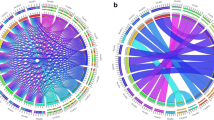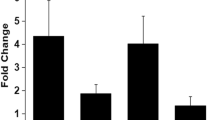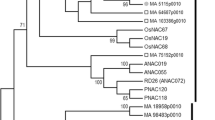Abstract
Callose synthesis occurs at specific stages of plant cell wall development in all cell types, and in response to pathogen attack, wounding and physiological stresses. We determined the expression pattern of “upstream regulatory sequence” of 12 Arabidopsis callose synthase genes (CalS1–12) genes and demonstrated that different callose synthases are expressed specifically in different tissues during plant development. That multiple CalS genes are expressed in the same cell type suggests the possibility that CalS complex may be constituted by heteromeric subunits. Five CalS genes were induced by pathogen (Hyaloperonospora arabidopsis, previously known as Peronospora parasitica, the causal agent of downy mildew) or salicylic acid (SA), while the other seven CalS genes were not affected by these treatments. Among the genes that are induced, CalS1 and CalS12 showed the highest responses. In Arabidopsis npr1 mutant, impaired in response of pathogenesis related (PR) genes to SA, the induction of CalS1 and CalS12 genes by the SA or pathogen treatments was significantly reduced. The patterns of expression of the other three CalS genes were not changed significantly in the npr1 mutant. These results suggest that the high induction observed of CalS1 and CalS12 is Npr1 dependent while the weak induction of five CalS genes is Npr1 independent. In a T-DNA knockout mutant of CalS12, callose encasement around the haustoria on the infected leaves was reduced and the mutant was found to be more resistant to downy mildew as compared to the wild type plants.









Similar content being viewed by others
Abbreviations
- as-1 :
-
Activating sequence 1
- BTH:
-
Benzothiadiazole
- CalS:
-
Callose synthase
- Gsl:
-
Glucan synthase-like
- GUS:
-
β-glucuronidase
- JA:
-
Jasmonic acid
- MeJA:
-
Methyl jasmonic acid
- NahG:
-
Naphthalene (salicylate) hydroxylase G
- Npr1 :
-
Nonexpresser of PR genes
- pmr4 :
-
Powdery mildew resistant 4
- SA:
-
Salicylic acid
- SAR:
-
Systemic acquired resistance
- TGA:
-
cis-acting element TGACG
- TGA-Bzip:
-
The basic leucine zipper transcription factors that recognize cis-acting element TGACG
- W-box:
-
cis-acting element (TTGAC) that is recognized by WRKY proteins
- WRKY proteins:
-
DNA-binding proteins containing a highly conserved WRKY sequence
References
Allen F, Friend J (1983) Resistance of potato tubers to infection by Phytophthora infestans: a structural study of haustorial development. Physiol Plant Pathol 22:285–292
Bechtold N, Ellis J, Pelletier G (1993) In planta Agrobacterium mediated gene transfer by infiltration of adult Arabidopsis thaliana plants. CR Acad Sci Ser III Sci Vie 316:1194–1199
Cao H, Bowling SA, Gordon AS, Dong X (1994) Characterization of an Arabidopsis mutant that is nonresponsive to inducers of systemic acquired resistance. Plant Cell 6:1583–1592
Cao H, Glazebrook J, Clarke JD, Volko S, Dong X (1997) The Arabidopsis NPR1 gene that controls systemic acquired resistance encodes a novel protein containing ankyrin repeats. Cell 88:57–63
Després C, DeLong C, Glaze S, Liu E, Fobert PR (2000) The Arabidopsis NPR1/NIM1 protein enhances the DNA binding activity of a subgroup of the TGA family of bZIP transcription factors. Plant Cell 12:279–290
Dong X (1998) SA, JA, ethylene, and disease resistance in plants. Curr Opin Plant Biol 1:316–323
Dong J, Chen C, Chen Z (2003) Expression profiles of the Arabidopsis WRKY gene superfamily during plant defense response. Plant Mol Biol 5:21–37
Dong X, Hong Z, Sivaramakrishnan M, Mahfouz M, Verma DP (2005) Callose synthase (CalS5) is required for exine formation during microgametogenesis and for pollen viability in Arabidopsis. Plant J 42:315–328
Donofrio NM, Delaney TP (2001) Abnormal callose response phenotype and hypersusceptibility to Peronospora parasitica in defense-compromised Arabidopsis nim1-1 and salicylate hydroxylase-expressing plants. Mol Plant Microbe Interact 14:439–450
Eulgem T, Rushton PJ, Robatzek S, Somssich IE (2000) The WRKY superfamily of plant transcription factors. Trends Plant Sci 5:199–206
Fan W, Dong X (2002) In vivo interaction between NPR1 and transcription factor TGA2 leads to salicylic acid-mediated gene activation in Arabidopsis. Plant Cell 14:1377–1389
Felton GW, Korth KL (2000) Trade-offs between pathogen and herbivore resistance. Curr Opin Plant Biol 3:309–314
Feys BJ, Parker JE (2000) Interplay of signaling pathways in plant disease resistance. Trends Genet 16:449–455
Gregory A, Smith C, Kerry M, Wheatley E, Bolwell G (2002) Comparative subcellular immunolocation of polypeptides associated with xylan and callose synthases in French bean (Phaseolus vulgaris) during secondary wall formation. Phytochem 59:249–259
Holub EB, Beynon JL (1997) Symbiology of mouse-ear cress (Arabidopsis thaliana) and oomycetes. Adv Bot Res 24:227–273
Hong Z, Zhang Z, Olson JM, Verma DPS (2001a) A novel UDP-glucose transferase is part of the callose synthase complex and interacts with phragmoplastin at the forming cell plate. Plant Cell 13:769–779
Hong Z, Delauney AJ, Verma DPS (2001b) A cell-plate specific callose synthase and its interaction with phragmoplastin. Plant Cell 13:755–768
Jacobs A, Lipka V, Burton R, Panstruga R, Strazhov N, Schulze-Lefert P, Fincher G (2003) An Arabidopsis callose synthase, GSL5, is required for wound and papillary callose formation. Plant Cell 15:2503–2513
Jefferson RA, Kavanagh TA, Bevan MW (1987) GUS fusions: β-glucuronidase as a sensitive and versatile gene fusion marker in higher plants. EMBO J 6:3901–3907
Johnson C, Boden E, Arias J (2003) Salicylic acid and NPR1 induce the recruitment of trans-activating TGA factors to a defense gene promoter in Arabidopsis. Plant Cell 15:1846–1858
Kalde M, Barth M, Somssich IE, Lippok B (2003) Members of the Arabidopsis WRKY group III transcription factors are part of different plant defense signaling pathways. Mol Plant Microbe Interact 16:295–305
Kinkema M, Fan W, Dong X (2000) Nuclear localization of NPR1 is required for activation of PR gene expression. Plant Cell 12:2339–2350
Kohler A, Schwindling S, Conrath U (2002) Benzothiadiazole-induced priming for potentiated responses to pathogen infection, wounding, and infiltration of water into leaves requires the NPR1/NIM1 gene in Arabidopsis. Plant Physiol 114:1255–1265
Kovats K, Binder A, Hohl HR (1991) Cytology of induced systemic resistance of cucumber to Colletotrichum lagenarium. Planta 183:484–490
Lam E, Benfey PN, Gilmartin PM, Fang RX, Chua NH (1989) Site-specific mutations alter in vitro factor binding and change promoter expression pattern in transgenic plants. Proc Natl Acad Sci USA 86:7890–7894
Li X, Zhang Y, Clarke JD, Li Y, Dong X (1999) Identification and cloning of a negative regulator of systemic acquired resistance, SNI1, through a screen for suppressors of npr1-1. Cell 98:329–339
McDowell JM, Dhandaydham M, Long TA, Aarts MG, Goff S, Holub EB, Dangl JL (1998) Intragenic recombination and diversifying selection contribute to the evolution of downy mildew resistance at the RPP8 locus of Arabidopsis. Plant Cell 10:1861–1874
Nishimura MT, Stein M, Hou BH, Vogel JP, Edwards H, Somerville SC (2003) Loss of a callose synthase results in salicylic acid-dependent disease resistance. Science 301:969–972
Ostergaard L, Petersen M, Mattsson O, Mundy J (2002) An Arabidopsis callose synthase. Plant Mol Biol 49:559–566
Pieterse CM, Dicke M (2007) Plant interactions with microbes and insects: from molecular mechanisms to ecology. Trends Plant Sci 12:564–569
Pieterse CM, Van Loon LC (1999) Salicylic acid-independent plant defence pathways. Trends Plant Sci 4:52–58
Pieterse CM, Van Loon LC (2004) NPR1: the spider in the web of induced resistance signaling pathways. Curr Opin Plant Biol 7:456–464
Richmond TA, Somerville CR (2001) Integrative approaches to determining Csl function. Plant Mol Biol 47:131–134
Rushton PJ, Torres JT, Parniske M, Wernert P, Hahlbrock K, Somssich IE (1996) Interaction of elicitor-induced DNA-binding proteins with elicitor response elements in the promoters of parsley PR1 genes. EMBO J 15:5690–5700
Ryals JA, Neuenschwander UH, Willits MG, Molina A, Steiner HY, Hunt MD (1996) Systemic acquired resistance. Plant Cell 8:1809–1819
Siebert PD, Chenchik A, Kellogg DE, Kukyanova KA, Lukyano SA (1995) An improved PCR method for walking in uncloned genomic DNA. Nucleic Acids Res 23:1087–1088
Skou J, Jorgensen JH, Lilhot U (1984) Comparative studies on callose formation in powdery mildew compatible and incompatible barley Hordeum vulgare. Phytopathol Z 109:147–168
Stone BA, Clarke AE (1992) Chemistry and physiology of higher plant 1, 3-β-glucans (callose). In: Stone BA, Clarke AE (eds) Chemistry and biology of (1, 3)-β-glucans. La Trobe University Press, Bundoora, pp 365–429
Subramaniam R, Desveaux D, Spickler C, Michnick SW, Brisson N (2001) Direct visualization of protein interactions in plant cells. Nat Biotechnol 19:769–772
Thomma B, Eggermont K, Penninckx I, Mauch-Mani B, Vogelsang R, Cammue B, Broekaert W (1998) Separate jasmonate-dependent and salicylate-dependent defense-response pathways in Arabidopsis are essential for resistance to distinct microbial pathogens. Proc Natl Acad Sci USA 95:15107–15111
Toller A, Brownfield L, Neu C, Twell D, Schulze-Lefert P (2008) Dual function of Arabidopsis glucan synthase-like genes GSL8 and GSL10 in male gametophyte development and plant growth. Plant J 54:911–923
Tucker MR, Paech NA, Willemse MT, Koltunow AM (2001) Dynamics of callose deposition and β-1, 3-glucanase expression during reproductive events in sexual and apomictic Hieracium. Planta 212:487–498
van Wees SC, Glazebrook J (2003) Loss of non-host resistance of Arabidopsis nahG to Pseudomonas syringae pv phaseolicola is due to degradation products of salicylic acid. Plant J 33:733–742
Verma DPS, Hong Z (2001) Plant callose synthase complexes. Plant Mol Biol 47:693–701
Vogel J, Somerville S (2000) Isolation and characterization of powdery mildew-resistant Arabidopsis mutants. Proc Natl Acad Sci USA 97:1897–1902
Worrall D, Hird DL, Hodge R, Paul W, Draper J, Scott R (1992) Premature dissolution of the microsporocyte callose wall causes male sterility in transgenic tobacco. Plant Cell 4:759–771
Yu D, Chen C, Chen Z (2001) Evidence for an important role of WRKY DNA binding proteins in the regulation of NPR1 gene expression. Plant Cell 13:1527–1540
Zhang YL, Fan WH, Kinkema M, Li X, Dong X (1999) Interaction of NPR1 with basic leucine zipper protein transcription factors that bind sequences required for salicylic acid induction of the PR-1 gene. Proc Natl Acad Sci USA 96:6523–6528
Zhou JM, Trifa Y, Silva H, Pontier D, Lam E, Shah J, Klessig DF (2000) NPR1 differentially interacts with members of the TGA/OBF family of transcription factors that bind an element of the PR-1 gene required for induction by salicylic acid. Mol Plant Microbe Interact 13:191–202
Acknowledgments
We thank Drs. J. McDowell (Virginia Technology Institute) for providing H. arabidopsis isolate Emco5; D. Bisaro (Ohio State University) for comments on this manuscript, and ABRC (Ohio State University) for seeds of Arabidopsis npr1-3, nahG, and T-DNA insertional lines. This work was supported by NSF grant IBN-0095112.
Author information
Authors and Affiliations
Corresponding author
Electronic supplementary material
Below is the link to the electronic supplementary material.
Rights and permissions
About this article
Cite this article
Dong, X., Hong, Z., Chatterjee, J. et al. Expression of callose synthase genes and its connection with Npr1 signaling pathway during pathogen infection. Planta 229, 87–98 (2008). https://doi.org/10.1007/s00425-008-0812-3
Received:
Accepted:
Published:
Issue Date:
DOI: https://doi.org/10.1007/s00425-008-0812-3




